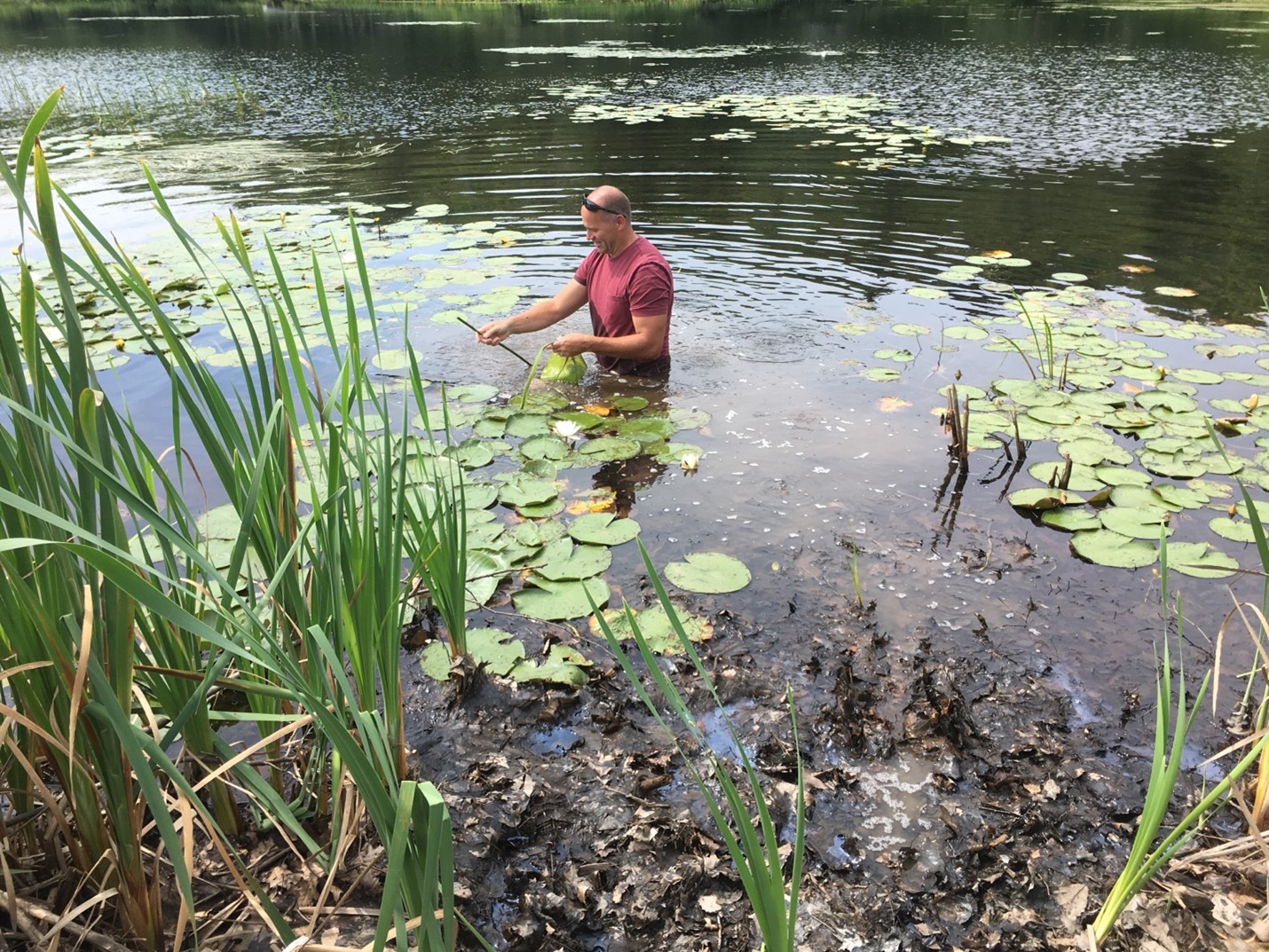Eric Doucette

Education
Ph.D., University of Maine, 2015
B.S., University of Maine, 2008
Courses Taught
BIOL 160: Introduction to Biology II; Organisms
BIOL 235: Botany
BIOL 302: Applied Statistics in Biology
BIOL 322: Introduction to Bryology and Lichenology
BIOL 327: Plants and Society
BIOL 330: Biology Seminar
BIOL 334: Field Botany
BIOL 341: Conservation Biology
BIOL 353: Entomology
BIOL 354: Ecology
Almost all my courses are very hands-on and interactive, with many outdoor and “live specimen” experiences. Many also have a strong quantitative component, encouraging you to get comfortable with data-wrangling and dealing with biological and ecological data. Feel free to stop by my office if you want to chat about classes.
Research/Creative Interests
My primary research centers on the systematics (species-level relationships and classification) of the genus Amelanchier, shrubs and trees in the rose family (Rosaceae). With coauthors, I am currently working on a monograph of the genus. I am the president of the Josselyn Botanical Society (Maine’s botanical society) and am broadly interested in distributional patterns (floristics and phytogeography), regional conservation, speciation, and systematics of vascular plants, bryophytes, and lichens.
Because of these broad interests, there are ample opportunities for students to work with me on some of these projects or design their own. I encourage students who are interested in any of these or related projects to come speak with me regarding research and fieldwork opportunities. Some examples of ongoing projects that involve a lot of fieldwork and lab skills include the following:
1. Bryophyte inventory of the MCLA forest
2. Macrolichen inventory of the MCLA forest
3. Vascular plant inventory of the MCLA forest
4. Various plant systematics projects (usually consists of measuring morphological traits and learning how to perform analyses in the software R)
These projects are often a part of my classes, but I would love students who are interested in one of these groups to take an active research role. Please feel free to stop by my office any time to discuss involvement with my research.
In addition to these academic interests, I am also interested in green and traditional building, timber framing, and old woodworking tools. I have had some great conversations with students building their own houses or cabins.
Peer-refereed Publications (in reverse chronological order)
Gilman, A.V., E.T. Doucette, B. Engstrom, A. Marcus, and M.J. Peters. 2020. Additions to the New Flora of Vermont—II. Phytoneuron 2020-16: 1–17. Published 28 February 2020. ISSN 2153 733X.
Abbot, R.J., C. S. Campbell , M. B. Burgess , K.R. Cushman, E.T. Doucette, and A.V. Gilman. 2017. ROSACEAE, the Rose Family, in the New Manual of Vascular Plants of Northeastern United States and Adjacent Canada. New York Botanical Garden Press. https://nybgshop.org/rosaceae-rose-family-c61/
Cushman, K. R., M. B. Burgess, E. T. Doucette, G. A. Nelson, and C. S. Campbell. 2017. Species Delimitation in Tetraploid, Apomictic Amelanchier (Rosaceae). Systematic Botany 42(2): 234-256.
Burgess, M., K. Cushman, E. Doucette, C. Frye, and C. Campbell. 2015. Understanding diploid diversity: a first step in unraveling polyploid, apomictic complexity in Amelanchier (Rosaceae). American Journal of Botany 102: 2041-2057
Doucette, E. T. 2014. Two new vascular plant taxa established in Maine. Rhodora: 116: 967: 348-351.
Burgess, M., K. Cushman, E. Doucette, N. Talent, C. Frye, and C. Campbell. 2014. Effects of apomixis and polyploidy on diversification and geographic distribution in Amelanchier (Rosaceae). American Journal of Botany 101(8): 1375-87.
Campbell, C. S., M. Burgess, K. R. Cushman, E. T. Doucette, A. C. Dibble, and C. T. Frye. 2014. Amelanchier in FNA Editorial Committee, Flora of North America volume 9. Magnoliophyta: Rosidae (in part): Rosales (in part). Oxford University Press, New York.
Peer-refereed Publications (in prep.)
Doucette, E. T., K. R. Cushman, M. B. Burgess, G. Holman, M. Sheltra, and C. S. Campbell. Monograph of the genus Amelanchier (Rosaceae). Target journal: Systematic Botany.
Doucette, E. T. First record of Juncus compressus (Juncaceae) in Massachusetts. Target journal: Rhodora or Phytoneuron.
Doucette, E. T. Quantifying an invasion of Ficaria verna (Ranunculaceae) in western Massachusetts and southern Vermont. Target journal: Rhodora or Phytoneuron.
Peer-refereed Publications with students (in prep.)
Friedman, M., L. Labdi, and E.T. Doucette. Morphological variability in anthocyanic content in Hieracium maculatum. Target journal: Phytoneuron.
Howard, P., A. Zigmand, and E.T. Doucette. Bryophyte survey of the Massachusetts College of Liberal Arts Forest. Target journal: Rhodora.
Other Publications
Mittelhauser, G.H., M. Arsenault, D. Cameron, and E. Doucette. 2019. Grasses and Rushes of Maine. University of Maine Press, Orono, ME. 752 pp.
Doucette, E. T. 2015. Systematics of agamic complexes in Amelanchier (shadbush). PhD dissertation. University of Maine, Orono.
Doucette, E. 2013. Quantifying Syringa reticulata invasion in Aroostook County, Maine. Pages 45-47 in Mollicone, M., E. Doucette, M. Gottlieb, D. Spaulding, and R. Pope (Editors). Bulletin of the Josselyn Botanical Society, Number 14. Published by the Josselyn Botanical Society. (available upon request)
Campbell, C., E. Doucette, and G. Holman. 2013. The University of Maine Herbarium. Pages 15-17 in Mollicone, M., E. Doucette, M. Gottlieb, D. Spaulding, and R. Pope (Editors). Bulletin of the Josselyn Botanical Society, Number 14. Published by the Josselyn Botanical Society. (available upon request)
Mollicone, M., E. Doucette, M. Gottlieb, D. Spaulding, and R. Pope (Editors). 2013. Bulletin of the Josselyn Botanical Society of Maine, Number 14. Published by the Josselyn Botanical Society. 154 p. (available upon request)
Reviews
Doucette, E. 2011. Review of The Plants of Acadia National Park. G.H. Mittelhauser, L.L. Gregory, S.C. Rooney, and J.E. Weber. Rhodora, Vol. 113, No. 955: 353-354.
